The U.S. Naval Research Laboratory has now celebrated 100 years of service as the Navy’s corporate laboratory with a rich history of performing advanced scientific research and making significant contributions to U.S. military forces on, under, and above the seas.
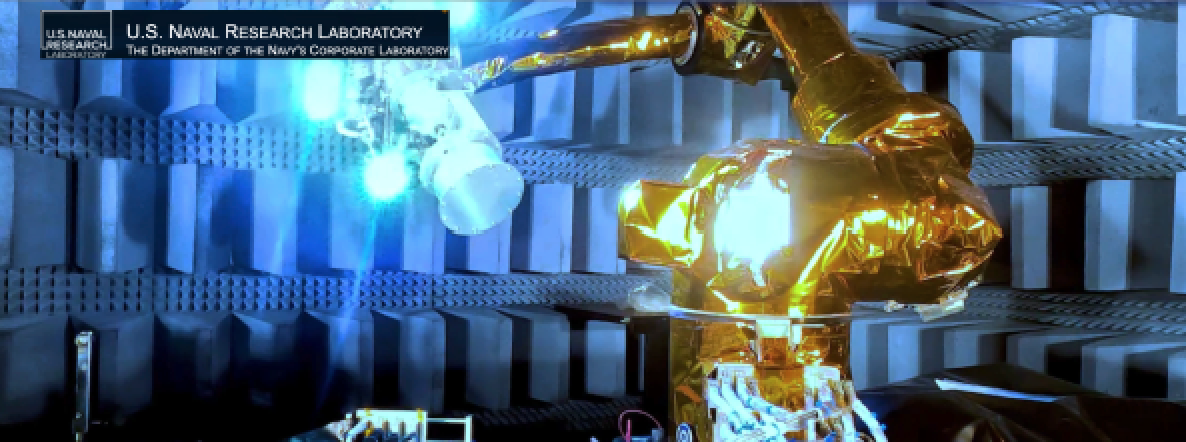
NRL engineers ready the Robotic Servicing of Geosynchronous Satellites (RSGS) payload for launch. The RSGS program is a public-private partnership
Commissioned on July 2, 1923, as the Naval Experimental and Research Laboratory — later shortened to the Naval Research Laboratory (c.1926) — NRL has changed the way the U.S. military fights, improved its capabilities, prevented technological surprise, transferred vital technology to industry, and tilted the world’s balance of power on at least three occasions; with the first U.S. radar, world’s first intelligence satellite, and first operational satellite of the Global Positioning System (GPS).
“For nearly a century, NRL employees have been at the forefront of innovation and research, and we are excited to honor this Centennial as we look to the next 100 years.” — Peter Matic, Ph.D., NRL’s Centennial Celebration Coordinator
A Vision Realized
In 1873, the U.S. federal government purchased 90 acres of Bellevue in southwest Washington D.C. and added this land to the adjacent Naval Gun Factory.
This land was known as the Bellevue Annex to the Naval Gun Factory until 1923, when the federal government opened the U.S. Naval Research Laboratory on the site. The Laboratory remains on this tract of land to this day.
In a 1915 New York Times article, Thomas Edison suggested that the U.S. government should maintain a “great research laboratory.” With this interview, and with the progression of World War I, the idea of a central research facility for the Navy began to take shape.
Secretary of the Navy, the Honorable Josephus Daniels, seized the opportunity created by Edison’s public comments to enlist Edison’s support. Edison agreed, serving as the head of a new body of civilian experts — the Naval Consulting Board — to advise the Navy on science and technology.
The Board’s eventual recommendation was “for the: establishment of a research and experimental laboratory, whose investment for grounds, buildings, and equipment should total approximately $5,000,000, and which should be located on tidewater of sufficient depth to permit dreadnought [class battleships] to come to the dock ... near, but not in, a large city, so that labor and supplies might be easily obtained.”
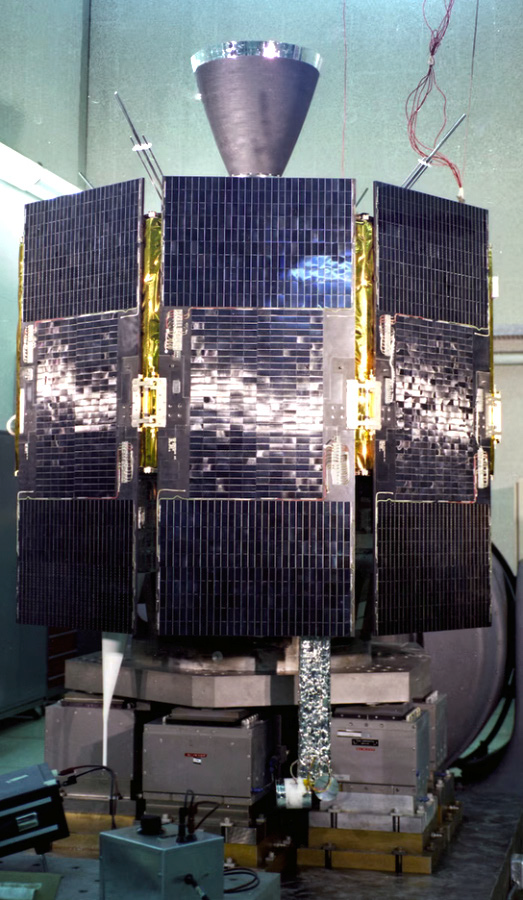
The first satellite in the GPS system, Navstar 1, was
launched on 22 February 1978. The photo above is of
NAVSTAR 2 — NTS-2 is the first satellite completely
designed and built by the U.S. Naval Research Laboratory
(NRL) under GPS Joint Program funding—a working model
was launched June 23, 1977, aboard an Atlas E/F rocket
from Vandenberg Air Force Base, California
The Board’s most ambitious plan was the creation of a modern research facility for the Navy. Congress allocated $1.5 million for the institution in 1916, but wartime delays and disagreements within the Naval Consulting Board postponed construction until 1920. On December 6, 1920, Daniels broke ground for NRL’s Building 1.
Radio Silence
In September of 1922, nearly eight months prior to the grand opening of the newly created laboratory, two Navy radio engineers — Albert Hoyt Taylor and Leo Clifford Young — who were stationed at the Naval Aircraft Radio Laboratory at Anacostia, just north of Bellevue, began to seek new frequencies for radio communication. Building a high-frequency transmitter and portable receiver, the two set out to ‘field-test’ their device.
As Taylor and Young were testing their new equipment across the half-mile stretch of the open Potomac, the steamer Dorchester was cruising up the Potomac from Alexandria. As the vessel steamed toward the Anacostia, the researchers took note to the discernable fluctuations and peaks they were observing on their equipment.
After somewhat tweaking the efficiency of the signal, the scientists were soon able to more effectively identify approaching vessels along the river, some as far off as three miles.
It was soon after this discovery the team truly believed they could further develop their device for practical military use in modernizing the efficiency of detecting enemy warships.
Unfortunately, neither the Navy nor the Bureau seemed interested, and Taylor and Young, in lieu of other demanding priorities, shelved the project before being moved slightly down river to the newly commissioned Bellevue lab several months later.
At NRL, Taylor became chief radio scientists of the Laboratory’s Radio Division and Young his top assistant. During the greater portion of the 1920s, the division was tasked with advancing high-frequency radio technology for service to the Navy fleet.
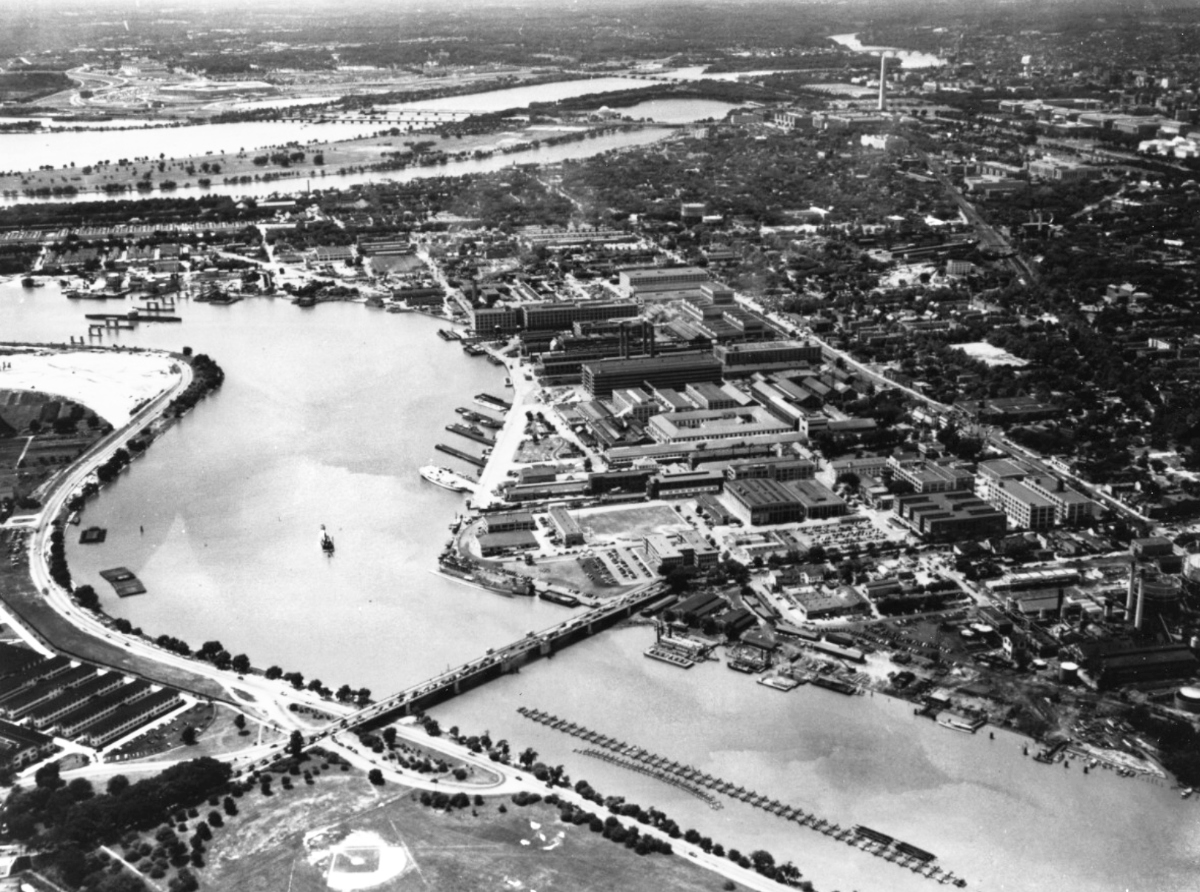
View of the Navy Yard and its vicinity, looking westward from over
Anacostia, circa 1947-1950. Photo is courtesy of Naval History &
Heritage Command.
1923 + Beyond
After opening its doors, the laboratory’s two original divisions — Radio and Sound — pioneered in the fields of high-frequency radio and underwater sound propagation. They produced communications equipment, direction- finding devices, sonar sets, and perhaps most significant of all, the first practical radar equipment built in the U.S.
Nearly a decade after Taylor and Young’s breakthrough in detecting distant moving objects via radio, a patent for “System for Detecting Objects by Radio,” was approved on November 27, 1934.
Later referenced as radar — for ‘radio detection and ranging’ — the technology contributed to major Naval victories in battles at the Coral Sea, Midway, and Guadalcanal during World War II.
During the war, scientific activities necessarily were concentrated almost entirely on applied research.
New electronics equipment — radio, radar, sonar — was developed.
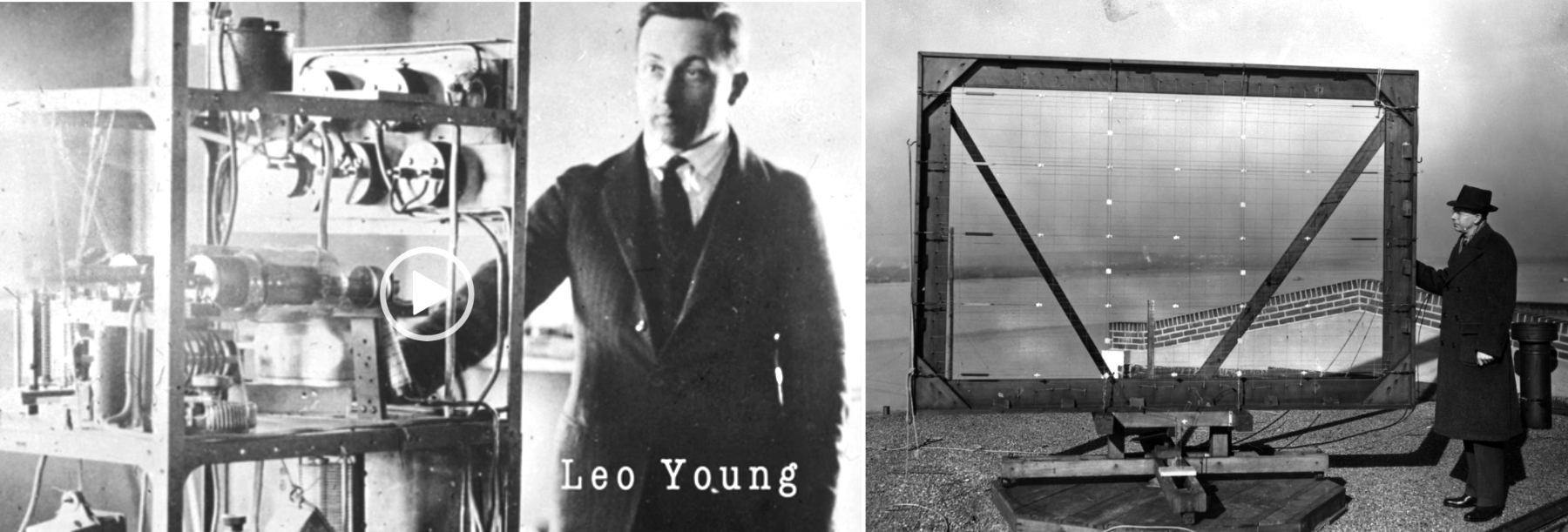
Photo of radio engineer Leo Clifford Young and an early
radar test installation
Countermeasures were devised. New lubricants were produced, as were antifouling paints, luminous identification tapes, plua a sea marker to help save survivors of disasters at sea. A thermal diffusion process was conceived and used to supply some of the uranium-235 isotope needed for one of the first atomic bombs.
During the years since World War II, the laboratory has conducted basic and applied research pertaining to the Navy’s environments of Earth, Sea, Sky, Space, and Cyberspace.
Investigations have ranged widely — from monitoring the sun’s behavior, to analyzing marine atmospheric conditions, to measuring parameters of the deep oceans.
Laboratory researchers also performed basic research, participating for example, in the discovery and early exploration of the ionosphere.
Moreover, the laboratory was able to work gradually toward its goal of becoming a broadly based research facility.
By the start of World War II, five new divisions had been added: Physical Optics, Chemistry, Metallurgy, Mechanics and Electricity, and Internal Communications.
Detection and communication capabilities have benefited by research that has exploited new portions of the electromagnetic spectrum, extended ranges to outer space, and provided a means of transferring information reliably and securely to stare down massive jamming tactics.
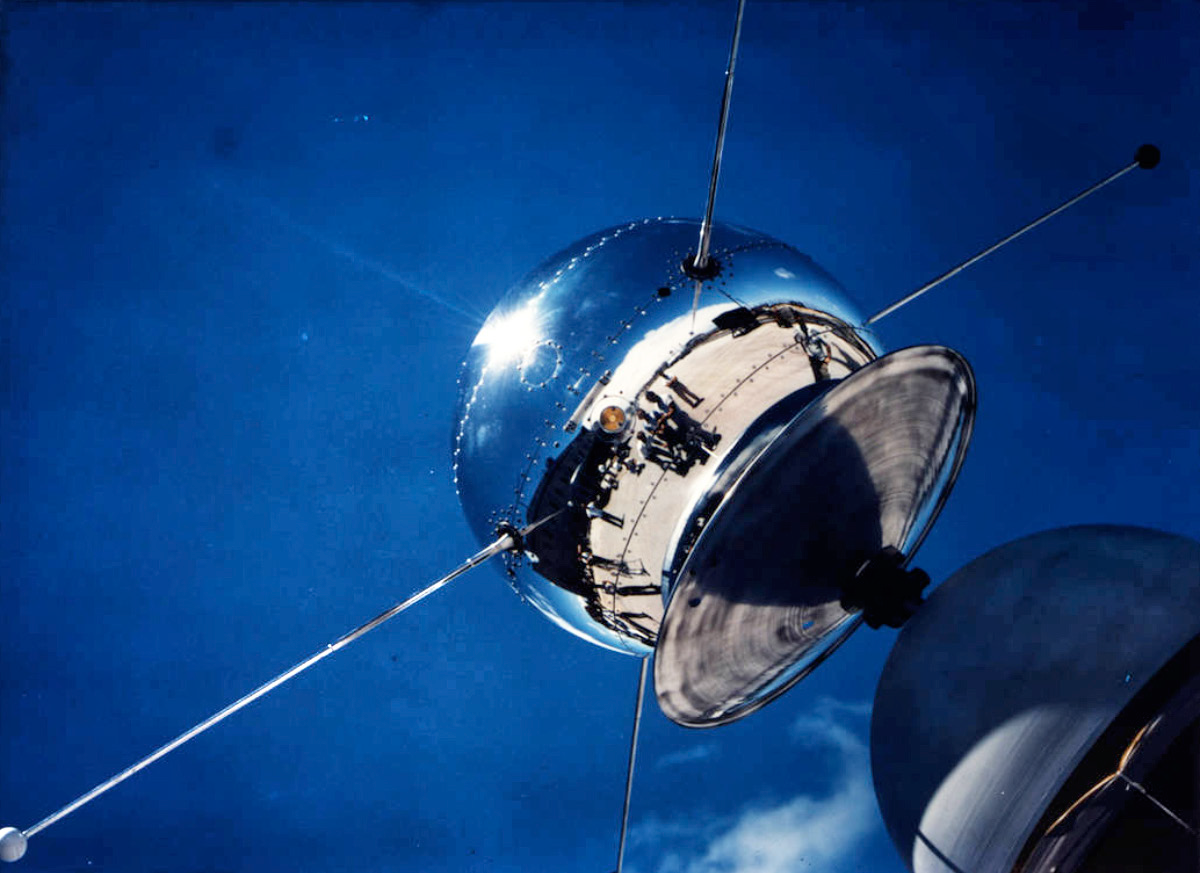
Photo of the Vanguard satelllite, courtesy of NRL.
Submarine habitability, lubricants, shipbuilding materials, firefighting, and the study of sound in the sea have remained steadfast concerns, to which have been added recent explorations within the fields of virtual reality, superconductivity, biotechnology and nanotechnology.
The laboratory has pioneered naval research into space — from atmospheric probes with captured V-2 rockets, through direction of the Vanguard project (America’s first satellite program) and development of the world’s first intelligence satellite (GRAB-I), to inventing and developing the first satellite prototypes of the modern day GPS.
Due to the major scientific accomplishments of the war years, the United States emerged into the post-war era determined to consolidate its wartime gains in science and technology and to preserve the working relationship between its armed forces and the scientific community.
While the Navy was establishing its Office of Naval Research (ONR) as a liaison with and supporter of scientific research, it was also encouraging NRL to broaden its scope. Placement of NRL within the Navy Secretariat allowed it to pursue long-range high-risk projects and serve the Navy in the broadest sense.
Commissioned on August 1, 1946, there was a transfer of NRL to the administrative oversight of ONR and a parallel shift of the laboratory’s research emphasis to one of long- range basic and applied investigation in a broad range of the physical sciences. However, rapid expansion during the war had left NRL improperly structured to address long-term Navy requirements.
One major task — neither easily nor rapidly accomplished — was that of reshaping and coordinating research. This was achieved by transforming a group of largely autonomous scientific divisions into a unified institution with a clear mission and a fully coordinated research program.
The first attempt at reorganization vested power in an executive committee composed of all the division superintendents. This committee was impracticably large, so in 1949 a civilian Director of Research (DOR) was named and given full authority over the program. Positions for associate directors, or ADORS, were added in 1954.
Leading Naval Research Into The Future
Today, NRL leads advances for the Navy in space systems development and support, as well as in fire research, tactical electronic warfare, microelectronic devices, and artificial intelligence (AI). The laboratory now focuses its research efforts on new Navy strategic interests in the 21st century, a period marked by global terrorism, shifting power balances, and irregular and asymmetric warfare.

NRL scientists and engineers strive to give the Navy the special knowledge, capabilities, and flexibility to succeed in this dynamic environment. While continuing its programs of basic research that help the Navy anticipate and meet future needs, to include innovations in wireless transfer of solar energy; hypersonic technologies and quantum information science.
NRL also moves technology rapidly from concept to operational use when high-priority, short-term needs arise. Some past examples are pathogen detection, lightweight body armor, contaminant transport modeling, and communications interoperability.
The interdisciplinary and wide-ranging nature of NRL’s work keeps this “great research laboratory” at the forefront of discovery and innovation, solving naval challenges and benefiting the nation as a whole.
Author Megan Gilliland is the Head of Public Affairs for the U.S. Naval Research Laboratory.


